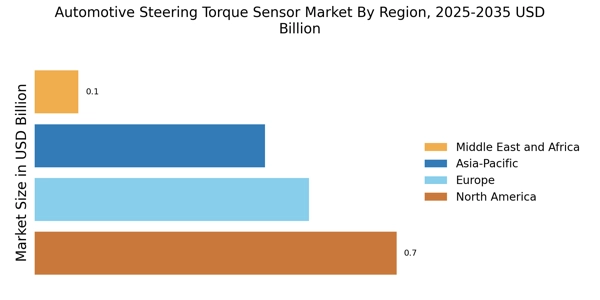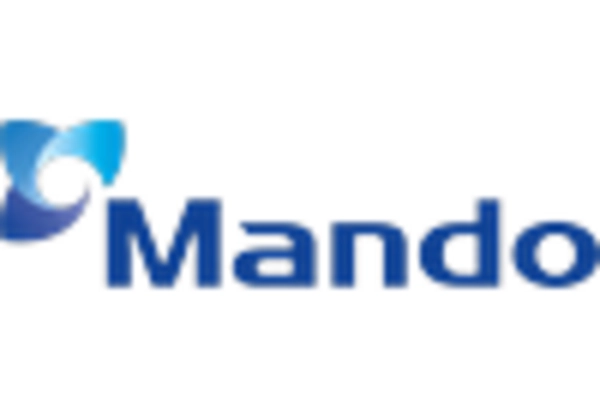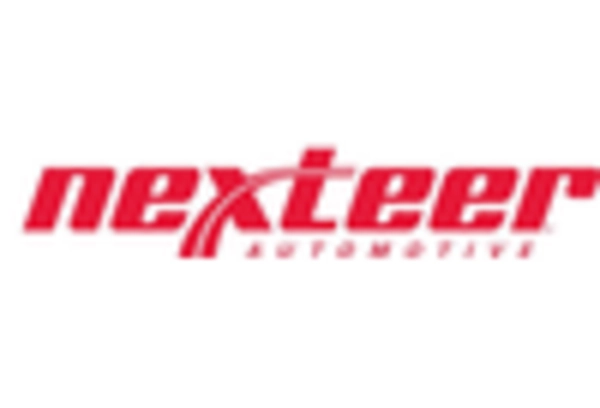Rising Demand for Enhanced Vehicle Safety
The Automotive Steering Torque Sensor Market is experiencing a notable surge in demand driven by the increasing emphasis on vehicle safety. As consumers become more aware of safety features, manufacturers are integrating advanced steering torque sensors to enhance vehicle stability and control. This trend is reflected in the growing adoption of safety regulations and standards across various regions. For instance, the implementation of stringent safety norms has led to a projected increase in the market size, with estimates suggesting a growth rate of approximately 7% annually. Consequently, the Automotive Steering Torque Sensor Market is poised to benefit from this heightened focus on safety, as automakers strive to meet consumer expectations and regulatory requirements.
Growth of Electric and Hybrid Vehicle Segments
The shift towards electric and hybrid vehicles is a pivotal driver for the Automotive Steering Torque Sensor Market. As automakers transition to more sustainable vehicle options, the demand for efficient steering systems that can accommodate electric powertrains is rising. This transition is expected to create new opportunities for steering torque sensors, which are essential for ensuring precise control in these vehicles. Market analysis suggests that the electric vehicle segment alone could account for a significant portion of the overall market, with estimates indicating a potential increase in market share by 15% within the next few years. Thus, the Automotive Steering Torque Sensor Market stands to gain substantially from this evolving automotive landscape.
Technological Advancements in Sensor Technology
Technological innovations are significantly influencing the Automotive Steering Torque Sensor Market. The development of more sophisticated sensors, including those utilizing MEMS (Micro-Electro-Mechanical Systems) technology, is enhancing the accuracy and responsiveness of steering systems. These advancements allow for better integration with electronic control units, thereby improving overall vehicle performance. Market data indicates that the introduction of these advanced sensors could lead to a market expansion, with projections estimating a compound annual growth rate of around 8% over the next five years. As a result, the Automotive Steering Torque Sensor Market is likely to witness increased investment in research and development, fostering further innovation.
Increasing Adoption of Autonomous Driving Features
The Automotive Steering Torque Sensor Market is being propelled by the increasing adoption of autonomous driving technologies. As vehicles become more automated, the need for precise steering control becomes paramount. Steering torque sensors play a critical role in enabling advanced driver assistance systems (ADAS) and fully autonomous vehicles by providing real-time feedback on steering inputs. This trend is supported by market forecasts that predict a substantial rise in the integration of these technologies, with estimates suggesting a market growth rate of approximately 10% annually. Consequently, the Automotive Steering Torque Sensor Market is likely to expand as manufacturers invest in the development of systems that enhance vehicle autonomy.
Regulatory Support for Advanced Automotive Technologies
Regulatory frameworks are increasingly supporting the development and integration of advanced automotive technologies, which is a key driver for the Automotive Steering Torque Sensor Market. Governments worldwide are implementing policies that encourage the adoption of innovative safety and efficiency measures in vehicles. This regulatory support is likely to stimulate demand for steering torque sensors, as they are integral to meeting these new standards. Market data indicates that regions with stringent automotive regulations are experiencing faster growth in sensor adoption, with projections suggesting a 6% increase in market size over the next few years. Therefore, the Automotive Steering Torque Sensor Market is expected to thrive in an environment that prioritizes technological advancement and safety.


















Leave a Comment